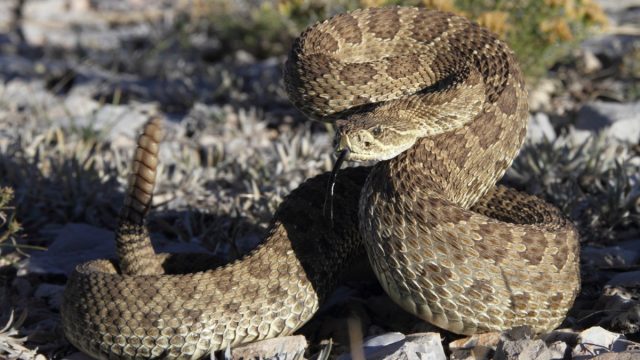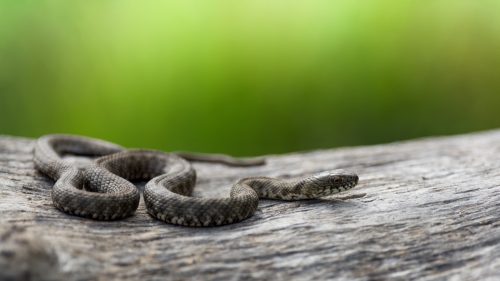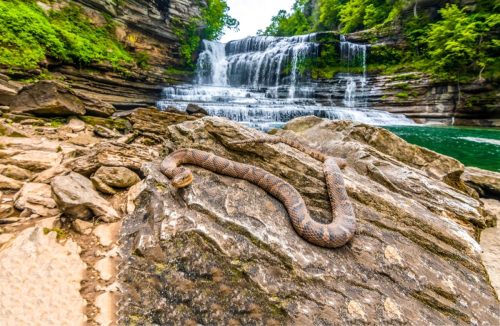Having This in Your Yard Could Attract Rattlesnakes, Experts Say

The rattlesnake might sound like a mythic beast confined to the realm of dusty hiking trails. But make no mistake: Rattlesnakes are very real—and very dangerous. In fact, according to research conducted by the American Academy of Family Physicians, rattlesnakes are singularly responsible for the lion’s share of snakebites in the nation. Even though snakebites are statistically rarely fatal (provided you get speedy medical attention), you still don’t want one. And the easiest way to avoid a bite is to avoid the snake’s natural environment. But it’s also all too possible a rattlesnake or two might already be hiding on your premises. Read on to find where—and learn what you can do to prevent them.
READ THIS NEXT: It’s Snake Bite Season: “Stay Away” From These Areas, Officials Warn.
Rattelsnakes are a uniquely American problem.

In exchange for a relatively temperate climate, the western hemisphere gets rattlesnakes—all three dozen species of them. “Rattlesnakes are only found in the Americas,” Sholom Rosenbloom, the owner of Baltimore-based Rosenbloom Pest Control tells Best Life. “Rattlesnakes can be found from southwestern Canada all the way down to central Argentina. Texas and Arizona have the greatest diversity of rattlesnake species in their respective states.”
In other words, if you’re stateside, you should always be on the lookout at least somewhat. The National Wildlife Federation notes that, while rattlesnakes technically make their home from coast to coast, you’re most likely to find them in the southwestern states: Arizona, New Mexico, parts of California, and so on. As cold-blooded creatures, they’re less likely to pop up during severe winter weather. “Snakes are most active throughout the summer, especially at night,” Rosenbloom notes.
READ THIS NEXT: If You Live Here, Watch Out for This Venomous Snake in Your Backyard.
Here’s where they could be hiding.

In nature, rattlesnakes love to hide where you’d expect, under rocks, in the shade of verdure, that sort of thing. But they also love to hide where you may not expect—your woodpiles, those carefully assembled stacks of logs that tend to proliferate during high s’mores season or when you’re using your fireplace.
“Rattlesnakes usually start infesting woodpiles in the spring as the weather gets warmer,” according to Nicholas Martin, a pest control consultant and the founder of Pest Control Hacks. “Rattlesnakes often choose woodpiles as a hideout because they find them safe enough to hide from predators… these serpents also use woodpiles as perfect shelter from [the] heat.”
In addition, Rattlesnakes seek out woodpiles for the same rationale that motivates all critters with a pulse: food. “Rattlesnakes mainly eat rodents,” Rosenbloom says. “Snakes have an amazing ability to follow the chemical trails of their prey, and tracking mice into your yard or house is one of the main reasons they’ll show up.” And since they’re a relatively agile reptile, they can “use narrow ‘corridors’ of woodpiles to hunt without spending too much energy,” Martin explains.
Yes, you can prevent them from showing up.

If rattlesnakes have no food source, there’s little reason for them to show up. You could, as Martin suggests, “treat the woodpiles around your house with insecticides and rodenticides to prevent insects and rodents from attracting snakes.” It’s a helpful tactic, but not an ironclad one.
Therefore, you’ll also want to make some structural changes. “If you have woodpiles, they should be 12 to 16 inches above ground,” Rosenbloom advises. At that height, rattlesnakes can’t feasibly access them from the ground. (You needn’t a herpetology lesson to see that snakes are limbless.) And you should move the pile as far away from your house as possible to prevent rattlesnakes from inadvertently wandering indoors.
RELATED: For more up-to-date information, sign up for our daily newsletter.
But if you see one, tread with caution.

“The Golden Rule for avoiding a snakebite is to never let your hands or feet go where you can’t see them,” Rosenbloom notes.
First, keep your distance. If you must move a snake, use a long wooden stick—Martin suggests a broom—to stir it out of rest. This should, in theory, spur the rattlesnake into finding another hiding spot, though the risk is that it’ll just end up in another place you can’t dislodge it from.
Your best bet is simply to ring up your local pest control. (Such services tend to be administered locally, as there’s no national hotline.) “Enjoy watching rattlesnakes from a safe distance, then let them go on their way,” Rosenbloom says. “That’s the best policy!”